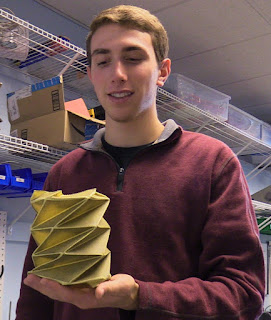Andrew Pfefer Story
As
a child, Andrew Pfefer loved to go with his father, Vic, to Take Your Child to
Work Day at Ford Motor Company. Pfefer especially loved to design cars at the
event. He became very inquisitive and curious about the world of engineering.
According
to Pfefer’s parents, he would build models with popsicle sticks and Legos.
Pfefer’s love for cars has grown, and his creativity and curiosity continue to
aid him in engineering structures. This love eventually inspired his interest
in aerospace engineering, and led to his involvement in the Miura Project.
The Miura Project is an aerospace
engineering project that ran through 2017 at the University of Colorado,
Boulder. Miura is a form of origami that inspired the project’s structure. The
project’s team created a soft-shelled structure that can collapse and expand
again. The lightweight, small and reusable structure could be used to make
spaceflight more efficient and cost-effective.
Pfefer’s
father’s line of work first exposed him to cars, where he then became
interested. As a senior in high school, he designed a vertical spoiler for a
sports car. This project sparked his interest in aerospace engineering because
he realized he wanted to go on to build similar but more challenging projects.
Pfefer,
one of two systems engineers on this project, enjoys aerospace engineering
because it helps him broaden his learning, and engineer whole systems. He hopes
to ultimately work on a managerial team for a project that sends humans to
Mars. He believes that Miura could make travel to Mars possible because the
habitats could be used in spaceships or on the planet.
Anastasia
Muszynski, a team lead, proposed the project idea. The students pitched the
idea to the High Altitude Student Payload program, which is run through the
Louisiana Space Grant Consortium (LSGC). The LSGC accepted the project proposal
and the Colorado Space Grant Consortium, the Undergraduate Research
Opportunities Program and the Engineering Excellence Fund funded it.
In
September, undergraduates Pfefer, Dawson Beatty and Muszynski made a
breakthrough. The team created a model of a reusable crew payload for space
flight. A payload is the object that is the spacecraft’s main goal of
spaceflight, such as a human habitat to transport astronauts. Astronauts would
stay in the reusable crew payload throughout the flight. The team solved the
challenge by engineering a payload that can be tightly folded for
transportation then inflated in space, similar to a tent.
However,
at the beginning of the summer, the project nearly failed. According to Beatty,
the project manager, Pfefer noticed that the original deployment mechanism for
the project wouldn’t work because of a mistake in the design. Pfefer improvised
a fix, and he and other team members got to work. They had the project back on
track within 24 hours. From working with him this year, Beatty learned that
Pfefer is constant, steady, and reliable.
“Through
the entire project Drew was more the constant presence that people could rely
on through the project,” Beatty said. “He had a very steady hand, was always
optimistic and had more of a steady push towards the goal.”
As manager, Beatty selected
candidates for the team. He chose Pfefer as a systems engineer because of his
broad set of engineering and interpersonal skills, and can explain things
clearly and concisely. He showed promise in his achievements on the spoiler for
the sports car. Throughout the year, Pfefer impressed Beatty with his
dedication, long work hours, and ingenuity.
“I
could just hand things off to him without worrying about it. Like, if I gave it
to him it would be handled and I didn’t have to think about it anymore,” said
Beatty.
At
the close of the project, Miura succeeded in accomplishing the original project
goals. Last year’s focus was on the structure of the payload. Students at CU
proposed a project called Miura 2 for the new year, and the LSGC accepted the
proposal. The second chapter of the project will focus on pressure and thermal
control to improve on the basic structure.
Pfefer
was vital to this project’s success. Pfefer started to show signs of creativity
and ingenuity in elementary school in Take Your Child to Work Day, Lego club,
and model building. Pfefer added hard work and dedication to this skill set in
high school, when he ultimately succeeded in his goal of becoming
valedictorian. Pfefer used all of his valuable skills during the Miura project
to aid in propelling it to success.
“I
like to learn from other people,” he said. “That’s kind of my dream.”
February, 2018
February, 2018


Comments
Post a Comment